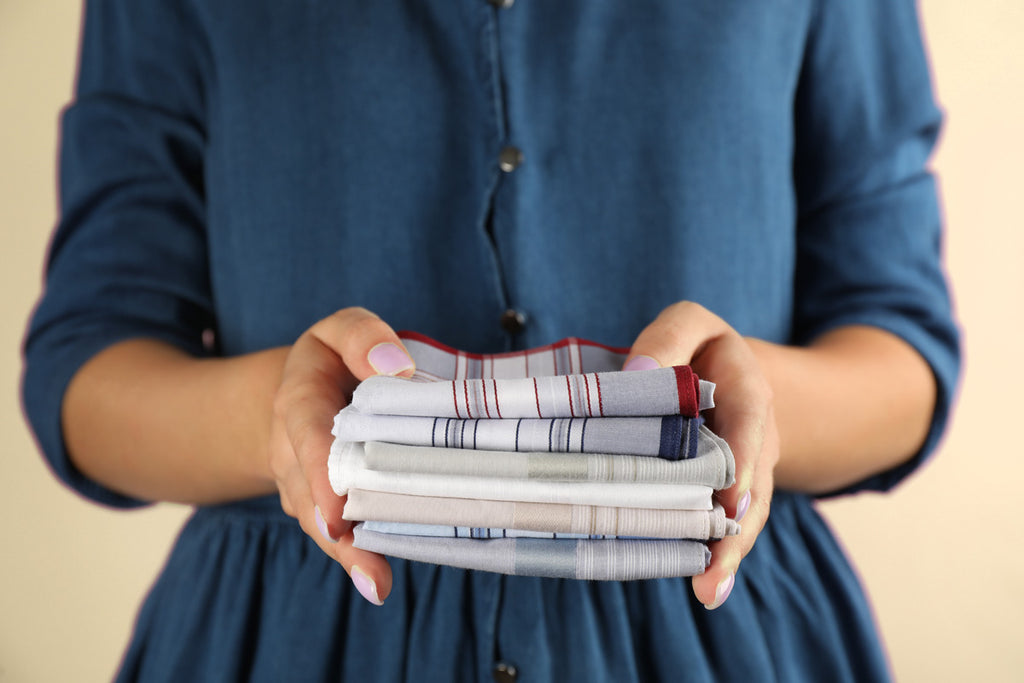Is the Handkerchief Dead? Exploring the Practicality and Style of a Timeless Accessory

The humble handkerchief played a major role in the 1985 establishment of R. Hanauer when Randy Hanauer saw a missing link in menswear. The traditional handkerchief was too big and bulky for the sartorial elegance demanded by the suit or sport coat. The white pocket square had a place in the market - and R. Hanauer would be the one to fill it.
Today, you’re rather hard-pressed to find a handkerchief close at hand. But why? In these post-COVID times of increased sanitary awareness that may be a rhetorical question. But let's explore the fascinating handkerchief history, its uses then and now, and how it stacks up against the pocket square.
What is a Handkerchief, Anyway?
At its simplest, a handkerchief is a hemmed, square piece of light, thin fabric held in the hand.
In Old English etymology it's defined as "a piece of cloth used about the person". That said, history has shown that it was also sometimes worn around the neck.
Heralded for their practicality, convenience, and versatility, they are normally carried in a pocket or purse - ever ready to wipe a runny nose or sweaty forehead, stifle a sneeze, or soak up tears of joy or sadness.

Early Handkerchief History
Evidence of cloth being carried for the purposes of hygiene dates back to ancient Egypt.
In the Middle Ages, when coarse fabrics were replaced with finer versions of linen, cotton and silk, the handkerchief became a status symbol among nobility.
By the 16th Century, the hanky was commonplace across Europe for both practical and decorative purposes.
Handkerchief uses included the wiping of blood, sweat, and tears (and germs), as well as covering the nose and mouth during outbreaks of sickness and disease.
They were also known to be scented with perfume or oil to mask unpleasant odors, or to remind a traveling loved one of the special person they’d left behind.

The Handkerchief as a Symbolic Communication Device
The 17th and 18th centuries were the golden ages of the handkerchief.
More popular and more fashionable than ever, the kerchief was a treasured gift between friends and a prized token of affection. They were large enough to showcase embroidery and monograms, and small enough to convey private, hand-sewn messages.

Embroidered linen handkerchief with lace, France, 1800s, Cleveland Museum of Art
Beyond literal secrets, the handkerchief communicated in other ways too. The specific way a handkerchief was folded or held could convey a discreet message. And we’ve all read about the white handkerchief being waved to signal a cease fire on the battlefield, epic races beginning with the enthusiastic flutter of a hanky, and women dropping their handkerchiefs in flirtation.
An unattached woman who purposefully dropped her hanky from a window would be aiming for one gentleman in particular. If he picked it up and carefully pocketed it, it was a sign that he matched her affection. Whereas if she dropped her kerchief in a public place for no one in particular, it meant she was open to suitors.

Parisian ladies with handkerchief, 1861, Rijksmuseum, Amsterdam
In lieu of an in-person breakup, lovers would simply send handkerchiefs back to their original owners as a symbol of “returned” love.
And in World War II, handkerchief maps were used by the Allied forces to guide lost soldiers back to safety.
Does Anyone Still Use Handkerchiefs?
Today, the handkerchief is all but dead – at least for its original purpose of hygiene. Disposable tissues have taken their place in that realm. And it’s a good thing too. Is it sanitary to use a handkerchief? Science says no.
Handkerchiefs however continue to be used by those who prefer a more sustainable and environmentally-friendly alternative to paper tissues, as they can be washed and reused multiple times. Companies like Vala Alta and Ernest et Lulu cater specifically to this market - and R. Hanauer of course offers its own baker's half dozen of soft, all-cotton handkerchiefs.

Sentimental pieces remain too, and some keep stylish iterations on board for fashion or tradition’s sake. So, while their popularity may have diminished, the handkerchief remains a functional and cherished item for many people.
Handkerchief vs Pocket Square: What Are the Differences?
The delineation between hanky and square is clear. The handkerchief, even if decorative and in finer fabrics, is not the same as a pocket square.
The handkerchief is intended for function, whereas the pocket square is for ornamental purposes only. Or in Randy Hanauer's immortal words: "Handkerchiefs are for blow - pocket squares are for show." The pocket square should never have a hand in wiping, blowing, mopping or soaking. Beyond sharing a shape, they have no real relationship.

The ornamental pocket square became mainstream in America between the 20s and 60s among stage and screen icons such as Fred Astaire, Louis Armstrong, Humphrey Bogart, Gary Cooper, and even the earliest Bonds.
The core job of the pocket square is to elevate an outfit. Along with an accompanying tie or bow tie, it adds style and personality to an ensemble without stealing the show.
Solid colors remain popular, and themed pieces and double sided pocket squares toe the line between classic and modern. Knowing both how to seamlessly pair your pocket square and other fine accessories, as well as how to fold it, is key to balance and refinement.
###
Have a handkerchief that’s meaningful to you, or a #RHanauer pocket square that you love to wear? Show us! We’re on Instagram and Facebook.
